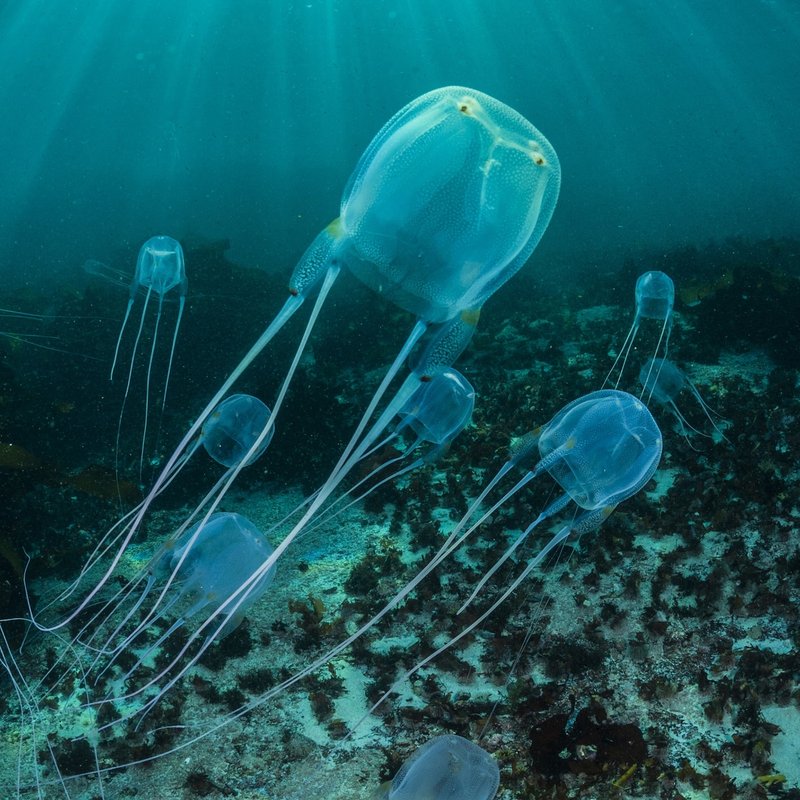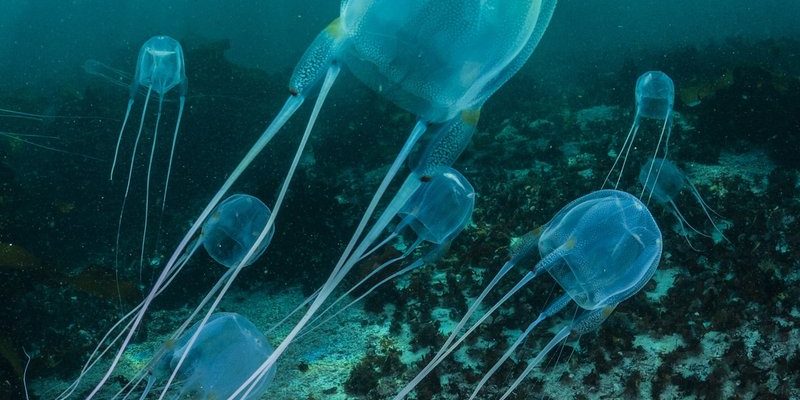
Box jellyfish are more than simple stingers; they form a part of a complex web of life in our oceans. Their interactions with other marine species, from the tiniest plankton to larger predators, help maintain the balance of their environment. Understanding their place in the ecosystem can reveal how interconnected life in the ocean truly is. So, let’s dive deeper into this fascinating creature and explore its vital role in marine ecosystems.
What Are Box Jellyfish?
Box jellyfish belong to the class Scyphozoa, and their scientific name is *Chironex fleckeri*. They are known for their distinctive cube-shaped bell and long, trailing tentacles that can reach impressive lengths. When you see one up close, it almost looks like an alien creature. But don’t let the beauty fool you; box jellyfish are among the most venomous animals in the world.
These jellyfish are commonly found in warm coastal waters of the Indo-Pacific region. They prefer shallow waters, which is why swimmers often encounter them. Their venom contains toxins that can cause heart failure and pain, sometimes even leading to death in unfortunate encounters. However, this venom isn’t just for show; it plays a crucial role in their survival, allowing them to capture prey and defend against predators.
It’s interesting to note that their unique body structure, complete with specialized cells called cnidocytes, allows them to sting with remarkable precision. A single box jellyfish can pack a powerful punch, but they also have a purpose. In the grand design of their marine habitat, they contribute to the health of the underwater ecosystem.
The Ecological Impact of Box Jellyfish
You might be wondering how jellyfish, especially the venomous kind, play a positive role in marine ecosystems. The box jellyfish, despite its dangerous reputation, serves critical functions that support other life forms. For instance, they are part of the food chain. Various marine species, including certain types of fish and sea turtles, prey on jellyfish—box jellyfish included. This predation is essential for maintaining population balances and helping to regulate numbers of other marine animals.
In many ways, box jellyfish are like the traffic lights of the ocean—they help control movement and keep everything flowing smoothly. When their numbers fluctuate, they can influence the populations of their predators and prey, leading to ripple effects throughout the ecosystem. For example, if box jellyfish become scarce, the fish that rely on them for food may also decline, which could have significant consequences for broader marine life.
Moreover, box jellyfish contribute to nutrient cycling in the ocean. As they drift through the water, their bodies and waste break down, releasing nutrients that support growth for other organisms, like plankton. This nutrient release can enhance productivity in the ocean and contribute to the overall health of marine environments.
Box Jellyfish as Prey: Feeding the Food Web
While box jellyfish are formidable predators, they are not invincible. They become prey to various larger marine animals, which is where they play another critical role in the food web. Creatures like the leatherback sea turtle are known to feast on jellyfish, and their survival depends on these gelatinous meals.
This predation is essential because it helps keep box jellyfish populations in check. If their numbers were to swell unchecked, they could over-consume young fish and plankton, leading to ecological imbalances. So, when you think about how everything in nature is interconnected, the relationship between box jellyfish and their predators becomes crucial.
Additionally, communities of fish often form around jellyfish blooms, seeking shelter and food. This creates a mini-ecosystem within the ocean, where fish can find refuge from larger predators while also feeding on the jellyfish themselves.
Box Jellyfish and Their Venom: A Double-Edged Sword
The venom of the box jellyfish is both a weapon and a tool for maintaining its role in the ecosystem. On one hand, it serves as a powerful mechanism for capturing prey, allowing the jellyfish to immobilize or kill smaller fish and other organisms quickly. The venom contains toxins that can disrupt the nervous systems of its prey, making it easier for the jellyfish to digest its meals.
On the other hand, the potency of their venom means that box jellyfish must also be cautious of larger predators that could harm them. While they are formidable hunters, they are not invulnerable. Their venom acts as a deterrent to many would-be predators, ensuring their survival in a competitive environment.
Interestingly, scientists are studying box jellyfish venom for potential medical applications. Its unique properties might help develop new treatments for pain management and other medical conditions. So, while the box jellyfish’s sting is a fearsome defense, it might also lead to advancements in healthcare that benefit humans. Talk about a twist!
Box Jellyfish and Climate Change: A Growing Concern
Climate change is a hot topic affecting many marine species, including the box jellyfish. Warmer ocean temperatures can lead to increased jellyfish blooms, making it easier for these creatures to thrive. You might be thinking, “Isn’t that a good thing?” Well, not necessarily.
When box jellyfish populations surge, they can disrupt local ecosystems, leading to overgrazing of plankton populations and affecting fish stocks. This imbalance can have cascading effects on marine life and the fishing industries that depend on healthy fish populations. Furthermore, as jellyfish populations grow, they may increase encounters with humans, leading to more stings and potential health risks.
In addition, jellyfish blooms can indicate broader environmental issues, such as declining fish populations and nutrient imbalances caused by pollution or overfishing. This means that monitoring box jellyfish populations can provide insights into the health of marine ecosystems, serving as a warning sign of deeper problems.
Conservation and Management of Box Jellyfish
Given their complex role in marine ecosystems, proper management of box jellyfish populations is essential. Educating the public about the risks associated with jellyfish encounters is one part of the solution. Creating awareness can help reduce incidents of stings while promoting understanding of their ecological significance.
Researchers and marine biologists are also working to develop strategies to monitor box jellyfish populations effectively. This involves tracking their numbers, understanding their breeding patterns, and determining the factors that lead to blooms. By keeping an eye on these creatures, scientists can work to maintain balance in marine ecosystems.
In addition, conservation efforts to protect habitats where box jellyfish thrive are essential. Healthy coastal waters, free from excessive pollution and human interference, support diverse marine life, including jellyfish. By fostering these environments, we can ensure the continuation of the box jellyfish’s role in marine ecosystems.
Box jellyfish might seem like simple creatures drifting through the ocean, but they are so much more than that. They play vital roles in marine ecosystems, influencing food webs and contributing to nutrient cycling. Their presence serves as both a warning and a bellwether for the health of our seas.
Understanding these fascinating creatures can help us appreciate the complexities of marine life. While they can pose dangers to humans, their ecological contributions are crucial for maintaining balance in the ocean. As we strive to protect our marine environments, let’s remember that every creature, even the box jellyfish, has its place in the circle of life.

